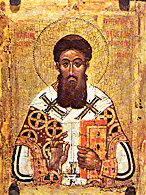 |
|
 |
Prevalence of hesychasm
 antakouzenos' victory in the civil war in 1347 also marked the victory of
antakouzenos' victory in the civil war in 1347 also marked the victory of
 the
hesychasts and the widespread acceptance of their teachings in Byzantine society. The controversy over hesychasm continued, nonetheless, and later, following the departure from Constantinople of
Gregory Akindynos,
the leadership of the anti-hesychasts was assumed by the scholar Nikephoros Gregoras. However, hesychasm had triumphed. At a Council held at the palace of Blachernai in 1351, it was recognised as the official doctrine of the Greek Church, while its defender, Gregory Palamas, was honoured as a saint almost immediately after his death (+1357/58). the
hesychasts and the widespread acceptance of their teachings in Byzantine society. The controversy over hesychasm continued, nonetheless, and later, following the departure from Constantinople of
Gregory Akindynos,
the leadership of the anti-hesychasts was assumed by the scholar Nikephoros Gregoras. However, hesychasm had triumphed. At a Council held at the palace of Blachernai in 1351, it was recognised as the official doctrine of the Greek Church, while its defender, Gregory Palamas, was honoured as a saint almost immediately after his death (+1357/58).
The adoption of hesychasm also signified the victory of the conservative Orthodox tradition during the first half of the 14th century and at the same time the rejection of the Latin Church and Western rationalism. It is characteristic that, contrary to the opinion of the members of the regency,
Anna of Savoy
and
Alexios Apokaukos,
who, at the beginning of the second civil war, had been ready to make important concessions to the Western Church in order to ensure the assistance of the Pope in the civil war, Kantakouzenos believed that only a Council based on terms of equality would be able to settle the issue of union. But the new civil war between
John V
and John VI did not favour the success of such negotiations.
See also: Hesychasm
Gregory Palamas
Nikephoros Gregoras
|